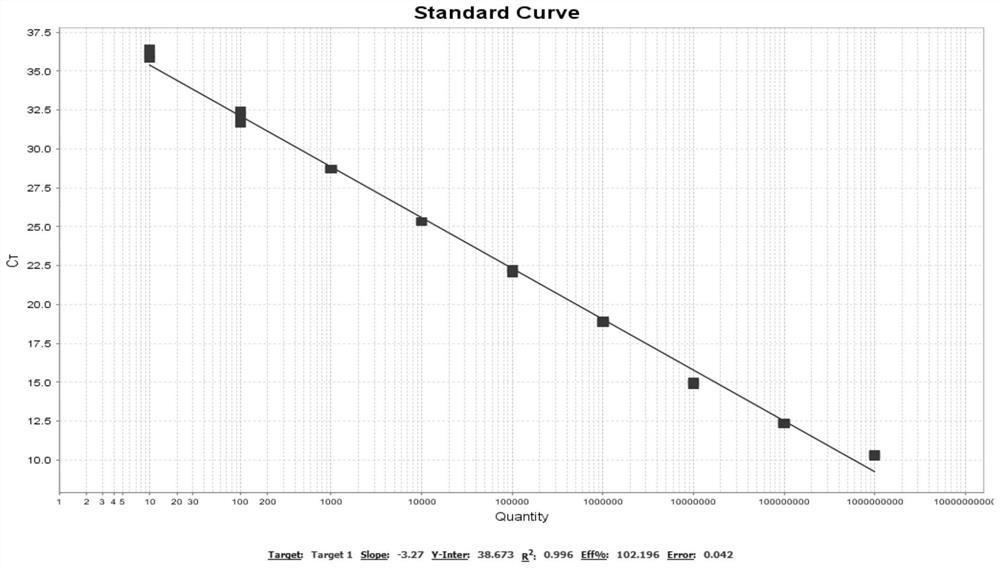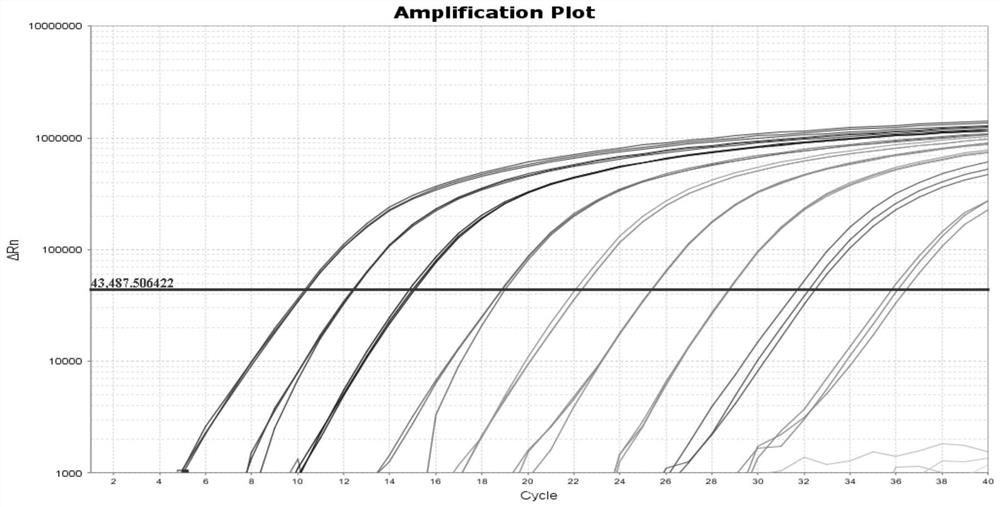TaqMan probe fluorescent quantitative PCR kit for Nipah virus and application thereof
A Nipah virus and fluorescence quantitative technology, which is applied in the determination/testing of microorganisms, DNA/RNA fragments, recombinant DNA technology, etc., can solve the problems of shortening operation time, unclear detection sensitivity, complex reaction system preparation, etc., and achieve repeatability Good performance, strong sensitivity, and the effect of meeting the requirements of qualitative and quantitative detection
- Summary
- Abstract
- Description
- Claims
- Application Information
AI Technical Summary
Problems solved by technology
Method used
Image
Examples
Embodiment 1
[0038] Embodiment 1 The establishment of qPCR reaction system
[0039] Download the N (nucleocapsid protein) gene (ID: AJ627196.1) sequence of Nipah virus from GenBank, and design a specific primer NiV-qF at 774 ~ 905 bp: 5'- TCTCCCAGAGTCTATCAGTAAGG -3' (SEQ ID No .1), NiV-qR: 5'- CCATACCAGTTTCCTCGACATAG -3' (SEQ ID No.2) and probe NiV-Probe: FAM-5'- AGGATCTGCTAAAGGCAGAGCAGT-3'-BHQ1 (SEQ ID No.3), the target fragment It is 132 bp; the synthetic vector is a recombinant plasmid of pUC57, the concentration is calculated according to the molecular weight and converted into copies / μL, and the template with the calculated copy number is diluted 10 times to prepare a standard. Primers, probes and plasmids were synthesized by Shanghai Sangon Bioengineering Co., Ltd.
[0040] Table 1: Primer and Probe Sequences
[0041]
[0042] Follow Novazym AceQ U + Probe Master Mix manual TaqMan qPCR reaction system Test reaction: 2×AceQ U + Probe Master Mix: 10 μL, NiV-qF (10 μM): 0.4 μL,...
Embodiment 2
[0049] Example 2 Sensitivity detection of qPCR reaction system
[0050] Dilute the NiV plasmid according to a 10-fold serial gradient, and perform a qPCR test according to the optimized reaction conditions to detect the sensitivity; each concentration gradient is repeated three times, and the standard curve is drawn with the obtained Ct value and the coefficient of variation (CV) is calculated to evaluate the method. repeatability. The total length of the NiV recombinant plasmid is 4299bp, and the concentration of the detected plasmid is 7ng / μL; the copy number of the standard product calculated according to the formula is 6.02×10 23 copies / mol×(7 ng / μL×10 -9 ) / (4299 ×660 g / mol)=1.48×10 9 copies / μL. with ddH 2 O 10-fold serial dilution to 1.48×10 1 copies / μL. Take 1 μL of the diluted standard plasmid as a template, and perform amplification according to the optimized qPCR conditions. The standard curve is as follows: figure 1 Shown: Y = -3.27×X+38.673 (R 2 =0.996)....
Embodiment 3
[0051] The specific detection of embodiment 3qPCR reaction system
[0052] Common infectious pathogen DNA or cDNA include: African swine fever virus (ASFV), porcine reproductive and respiratory syndrome virus (PRRSV), swine fever virus (CSFV), porcine pseudorabies virus (PRV), porcine epidemic diarrhea ( PED) etc. for qPCR detection to evaluate the specificity of the method.
[0053] Standards with different copy numbers (1.48×10 9 ~1.48×10 0 copies / μL) were measured three times, and the test results were statistically analyzed to test the repeatability of the method. The results are shown in Table 4. The coefficient of variation (CV; the ratio of the standard deviation to the mean) is less than 2%, indicating that the established method has good repeatability and stable results. as table 4 and figure 2 As shown, the lowest NiV plasmid concentration that can be detected by the established qPCR detection method for N gene is 14.8 copies / μL. At present, the fluorescent RT-...
PUM
| Property | Measurement | Unit |
|---|---|---|
| correlation coefficient | aaaaa | aaaaa |
Abstract
Description
Claims
Application Information
 Login to View More
Login to View More - R&D
- Intellectual Property
- Life Sciences
- Materials
- Tech Scout
- Unparalleled Data Quality
- Higher Quality Content
- 60% Fewer Hallucinations
Browse by: Latest US Patents, China's latest patents, Technical Efficacy Thesaurus, Application Domain, Technology Topic, Popular Technical Reports.
© 2025 PatSnap. All rights reserved.Legal|Privacy policy|Modern Slavery Act Transparency Statement|Sitemap|About US| Contact US: help@patsnap.com



